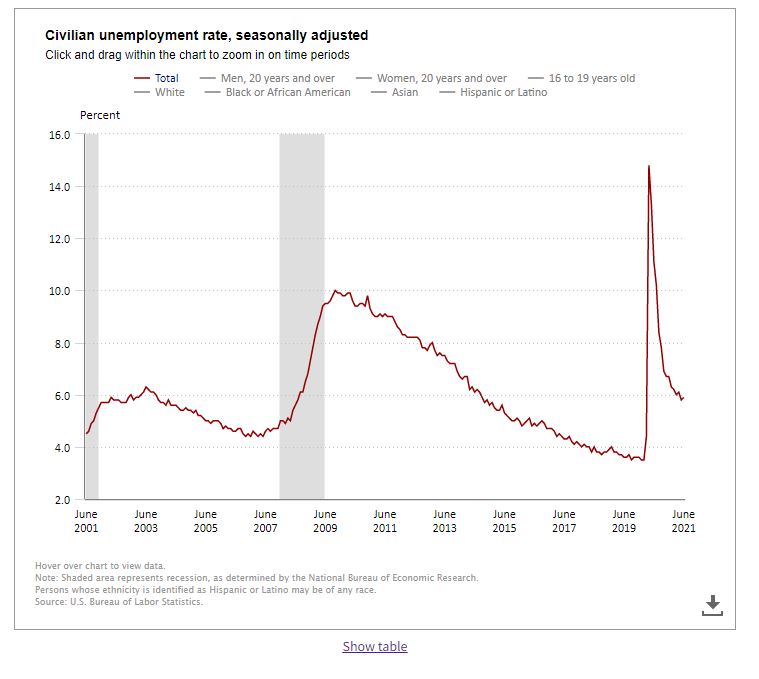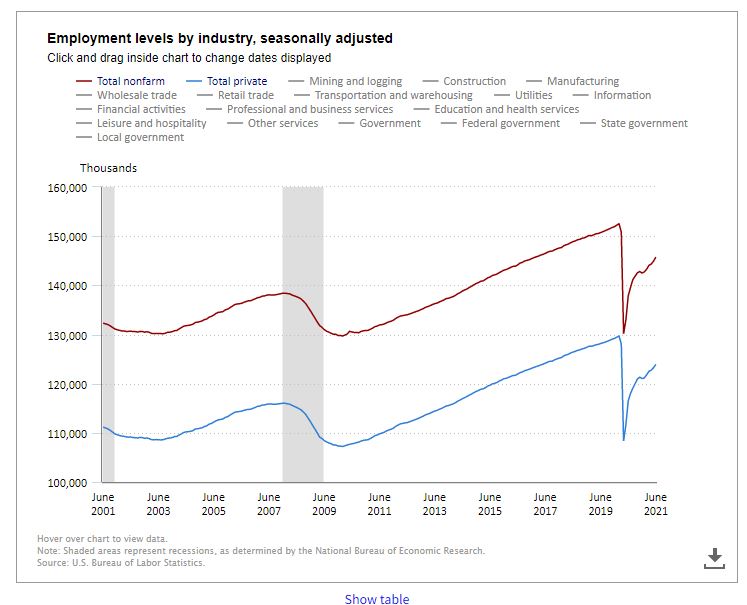Employment Blog July 2021
This Employment Blog is taken from the U S Department of Labor, Bureau of Labor Statistics. Nonfarm payroll employment rose by 850,000 in June, and the unemployment rate changed little at 5.9 percent. Notable job gains occurred in leisure and hospitality, public and private education, professional and business services, retail trade, and other services. Substantial job losses related to the coronavirus (COVID-19) pandemic first occurred in March (-1.7 million) and April (-20.7 million) of 2020. As economic activity resumed, employment increased by 12.6 million from May through November but declined again in December (-306,000) following a surge in the number of coronavirus cases. Job growth restarted in January of this year, and nonfarm payroll employment has increased by 3.3 million over the past 6 months as the number of vaccinations has increased, the number of coronavirus cases has fallen, and pandemic-related restrictions have been relaxed. Overall, nonfarm payroll employment is up by 15.6 million since April 2 2020. However, employment is down by 6.8 million, or 4.4 percent, from the pre-pandemic employment peak in February 2020.


Leisure and hospitality added 343,000 jobs in June as pandemic-related restrictions continued to ease in some parts of the country. Job gains continued in food services and drinking places (+194,000); accommodation (+75,000); and arts, entertainment, and recreation (+74,000). Leisure and hospitality has added 1.6 million jobs since January and accounts for about half of all the jobs added thus far this year. However, employment in the industry is down by 2.2 million, or 12.9 percent, since February 2020.
In June, employment increased in local government education (+155,000), state government education (+75,000), and private education (+39,000). In both public and private education, staffing fluctuations due to the pandemic, in part reflecting the return to in-person learning and other school-related activities, have distorted the normal seasonal buildup and layoff patterns, likely contributing to the job gains in June. (Without the typical seasonal employment increases earlier, there were fewer layoffs at the end of the school year, resulting in job gains after seasonal adjustment.) These variations make it more challenging to discern the current employment trends in these industries. Since February 2020, employment is down by 414,000 in local government education, by 168,000 in state government education, and by 255,000 in private education.
Professional and business services added 72,000 jobs in June, including 33,000 jobs in temporary help services. Employment is down by 633,000 in professional and business services since February 2020.
Employment in retail trade rose by 67,000 in June. Notable job gains in clothing and clothing accessories stores (+28,000) and general merchandise stores (+25,000) more than offset job losses in food and beverage stores (-13,000) and health and personal care stores (-7,000). Employment in retail trade is down by 303,000, or 1.9 percent, since February 2020.
In June, the other services industry added 56,000 jobs, with gains in personal and laundry services (+29,000), in membership associations and organizations (+18,000), and in repair and maintenance (+9,000). Since February 2020, employment is down by 297,000 in other services.
Social assistance employment increased by 32,000 in June, largely in child day care services (+25,000). Employment in social assistance is 236,000 lower than in February 2020.
In June, wholesale trade added 21,000 jobs, with gains in both durable goods (+14,000) and nondurable goods (+9,000). Since February 2020, employment in wholesale trade is down by 192,000.
In June, employment in mining rose by 10,000, reflecting job growth in support activities for mining (+10,000). Mining employment is down by 110,000 since a peak in January 2019.
Employment in manufacturing changed little in June (+15,000) and has shown little net movement since March. Employment in manufacturing is 481,000 below the February 2020 level.
Employment in transportation and warehousing also was little changed in June (+11,000). Employment in couriers and messengers fell by 24,000 over the month but is up by 117,000 since February 2020. Warehousing and storage (+14,000), air transportation (+8,000), and truck transportation (+6,000) added jobs over the month. Overall, employment in transportation and warehousing is 94,000 lower than in February 2020.
Construction employment was about unchanged in June (-7,000) and has shown little net change thus far this year. In June, nonresidential specialty trade contractors (-15,000) and heavy and civil engineering construction (-11,000) lost jobs, while residential specialty trade contractors (+13,000) gained jobs. Employment in construction is down by 238,000 since February 2020.
Employment in other major industries–including information, financial activities, and health care–showed little change over the month.
Real average weekly earnings decreased 0.9 percent over the month due to the change in real average hourly earnings combined with a decrease of 0.3 percent in the average workweek. Real average hourly earnings decreased 1.7 percent, seasonally adjusted, from June 2020 to June 2021. The change in real average hourly earnings combined with an increase of 0.3 percent in the average
workweek resulted in a 1.4-percent decrease in real average weekly earnings over this period.
